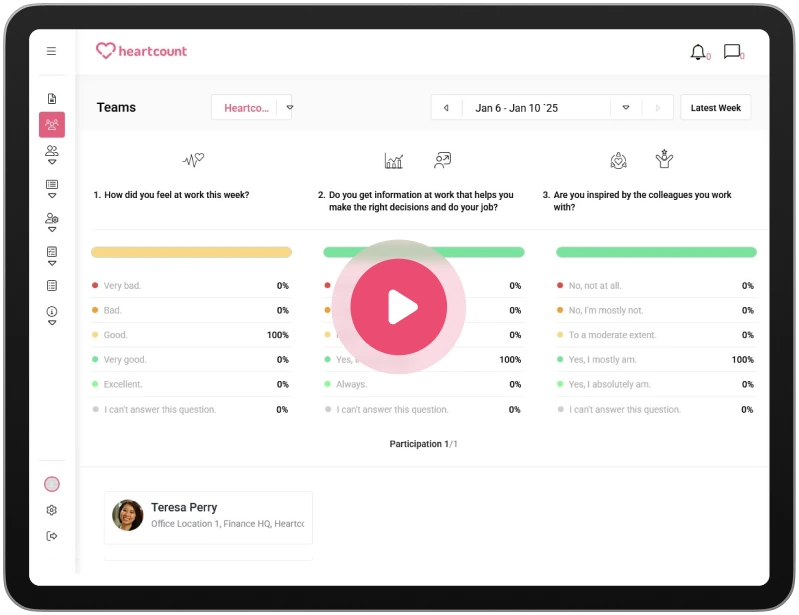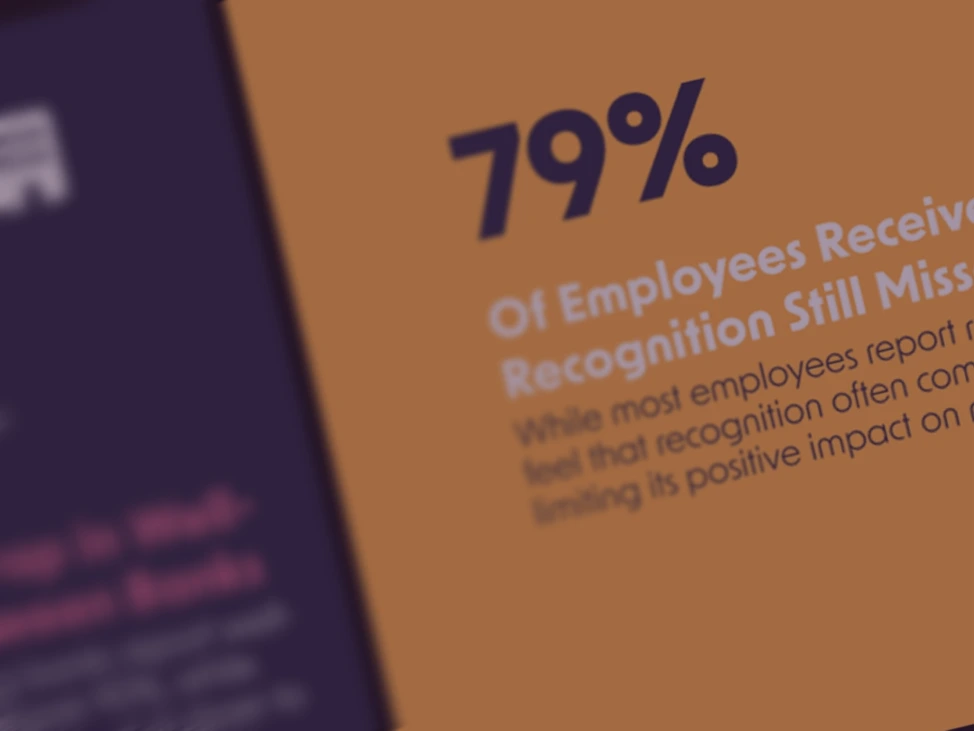Why Traditional Employee Satisfaction Surveys Fail

Employee satisfaction is one of the most important factors impacting employee retention. It reflects employees’ satisfaction with their work conditions, environment, roles, and organization they work for.
That’s why successful companies, aware of how satisfied employees can improve their business, regularly track this metric. The easiest way to measure employee satisfaction is through employee satisfaction surveys. As the level of satisfaction increases, employees are more likely to engage and remain with the company.
However, most companies’ typical approach to measuring employee satisfaction is fundamentally flawed. By improving employee satisfaction surveys, organizations can create a better workplace culture where people feel valued and recognized.
Employee satisfaction is one of the most important factors impacting employee retention. It reflects employees’ satisfaction with their work conditions, environment, roles, and organization they work for.
That’s why successful companies, aware of how satisfied employees can improve their business, regularly track this metric. The easiest way to measure employee satisfaction is through employee satisfaction surveys. As the level of satisfaction increases, employees are more likely to engage and remain with the company.
However, most companies’ typical approach to measuring employee satisfaction is fundamentally flawed. By improving employee satisfaction surveys, organizations can create a better workplace culture where people feel valued and recognized.
What is an employee satisfaction survey?
An employee satisfaction survey is crucial for human resource management to measure employee contentment at work.
By carefully creating survey questions, HR leaders can gain real-time insights into employee sentiment and understand how and why employees feel about various aspects of their work. Based on the gathered data, organizations can pinpoint areas for improvement.
The benefits of an employee satisfaction survey include:
- Honest communication between employees and management
- Direct employee feedback
- Increased retention rate
- Valuable insight into satisfaction over time
- Data-driven decision-making
- Anticipation and prevention of employee turnover
Ultimately, prioritizing employee satisfaction survey results leads to enhanced employee engagement, stronger commitment, and increased loyalty to the company.
What are the common reasons why traditional employee satisfaction surveys fail
It’s not just about having lengthy survey questions to share with your employees. What truly matters is how you create this list to gather employee feedback effectively.
When HR leaders consistently use one survey template without customization, they may have a low response rate.
Here are some of the most common reasons why traditional surveys fail:
- They have too many questions
One of the most common reasons employees provide incomplete responses or fail to respond to the employee survey is the number of questions. Employees often complain about “survey fatigue.”
What does this mean?
Annual job satisfaction surveys often have over 100 questions, which can make respondents feel fatigued and overwhelmed. The number of questions directly impacts the quality and reliability of the data you collect.
It’s better to send several questions more frequently than one lengthy survey to increase the participation rate. This way, the employee wouldn’t need much time and effort to share feedback.
For example, HeartCount has a weekly pulse survey. It includes only a couple of questions covering eight employee engagement categories.
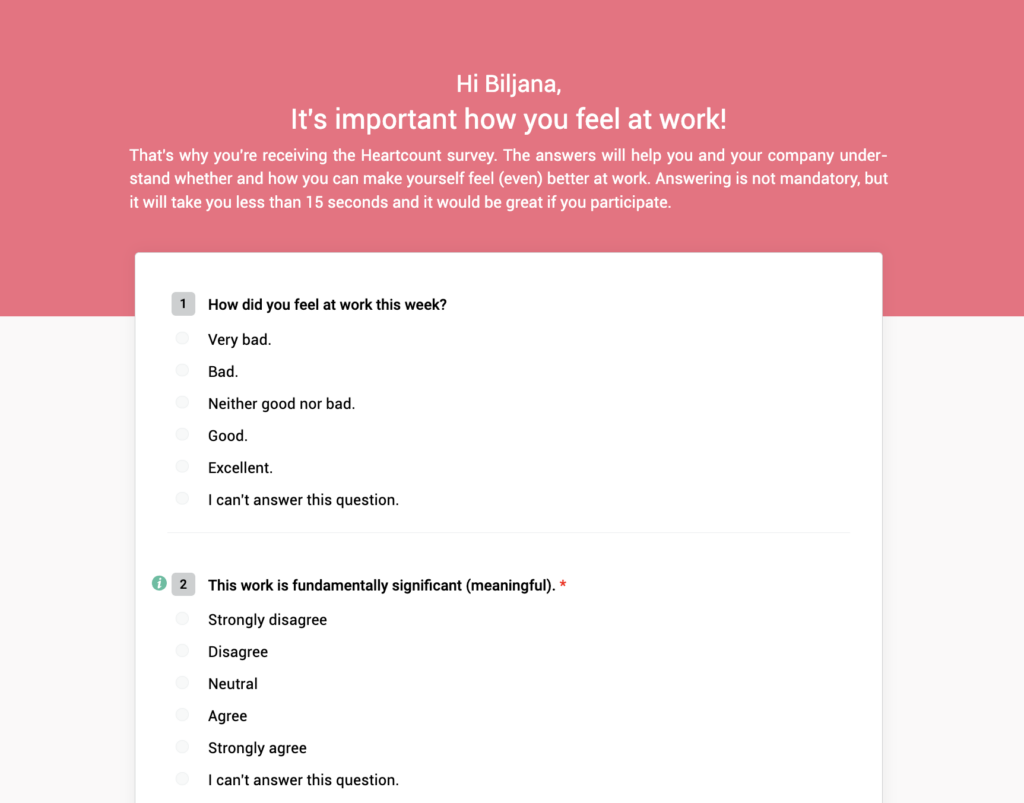
- They’re conducted too rarely
Typically, employee satisfaction surveys are conducted annually, meaning there might be a huge lag between an issue arising in the workplace and its discovery and resolution.
This makes employee satisfaction surveys nearly useless.
- There is a significant time lag between surveys and results
In many cases, months pass from when employees fill out the survey until they see the results. By then, no one will remember the survey questions anymore and the results will most likely be outdated before people even see them.
Here’s how it goes in many workplaces:
- April: The survey comes out
- May: Results are due
- August: Results become available
- September: Departments and teams start following up on results
When employee surveys were conducted using physical paper surveys, processing the results took more time due to manual handling. Today, you can digitalize your surveys.
Thanks to employee experience software like HeartCount, you can conduct surveys and process results in just a few minutes. Moreover, managers and HR leaders can immediately see the results of employee surveys.

- Survey creates positive expectations – but nothing happens
Asking employees about their current situation creates an expectation that the workplace will act on the survey results.
However, for various reasons, management often fails to take action to improve employee satisfaction.
When survey results aren’t acted upon, employees get the impression that this is a sham process and that the company wants to create the illusion that it cares when, in reality, it doesn’t.
This only increases frustration and employee morale.
- No perceived value for employees
One important aspect often overlooked is encouraging and motivating employees to respond to surveys.
Employees who can’t see the value of employee satisfaction survey questions will not be eager to participate. Expectedly, this leads to miserable response rates in many workplaces, as employees feel like they waste time filling out the survey.
Therefore, you must ensure that each question resonates with their real problems and that their concerns are considered and addressed.
- Negative focus
The purpose of employee satisfaction surveys is not only to identify areas for improvement but also to highlight what the company is doing right.
Many organizations only pay attention to areas with low scores or where they have fallen since the last survey.
Also, they often focus solely on the most dissatisfied team, neglecting those teams that are happier than others. These overlooked teams get no attention from the management, as all the focus is on the lowest-scoring teams.
Indeed, a survey should be used to pinpoint problems so they can be fixed. But if that’s all it’s used for, the company misses a huge opportunity to identify and spread best practices by learning from the best-performing areas and teams.
Best practices for creating an effective satisfaction survey
Keep in mind that there are no one-size-fits-all surveys. Each employee survey question should be aligned with your organization and your goals for the results.
However, some general practices can make your survey more effective.
- Reduce the number of employee satisfaction survey questions
As mentioned above, the number of questions decreases the participation rate.
Keep your surveys concise and to the point, with just a few questions covering the most critical aspects of satisfaction.
If an employee survey requires more than 7-8 minutes to answer, response rates decrease by up to 20%. Respect your employees’ time.
- Make it easy to complete
Surveys have to be accessible so that employees can be filled in without any effort. Use responsive design and easy-to-comprehend questions for effortless completion.
- Send surveys regularly
Every workday can bring situations that lead to employee dissatisfaction. That’s why it’s important to ask your employees about their experiences and feelings regularly.
Conduct surveys regularly. You can choose weekly, bi-weekly, or monthly checkups so your employees can anticipate them.
Moreover, consistency will ensure all their issues are addressed promptly.
- Maintain transparency
Employees often fear being honest in surveys due to a lack of transparency and a misunderstanding of the end goal.
Speak openly with your team about the purpose of the survey and how you will use the results to make positive changes.
Implement digital solutions to run employee satisfaction surveys more easily
Sorting and analyzing responses is the most time-consuming task for HR departments. However, with modern HR tools and software, creating, sending, and analyzing employee satisfaction has become effortless.
Software solutions like HeartCount measure the team’s pulse weekly or enable organizations to create customized surveys. You can also save them as a survey template.
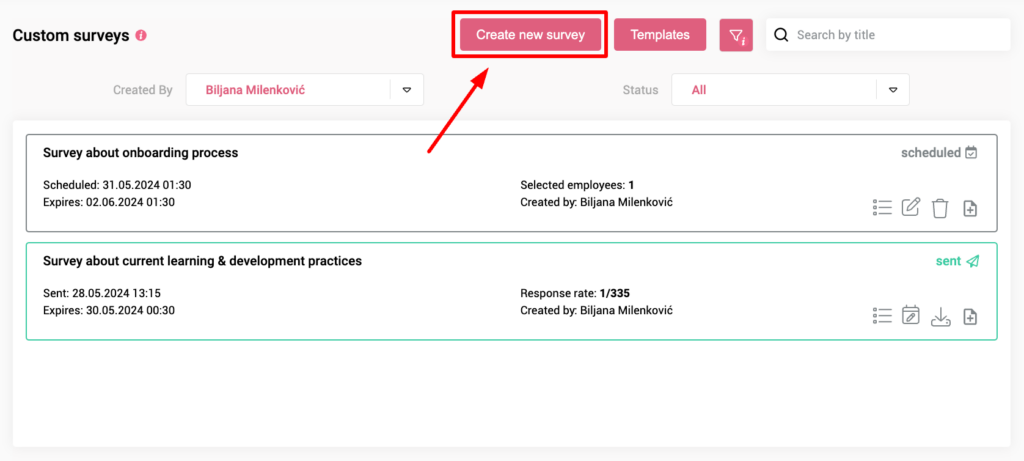
A showcase of how to create a new custom survey with HeartCount
You can tailor questions, schedule their distribution, and target specific teams or individuals.
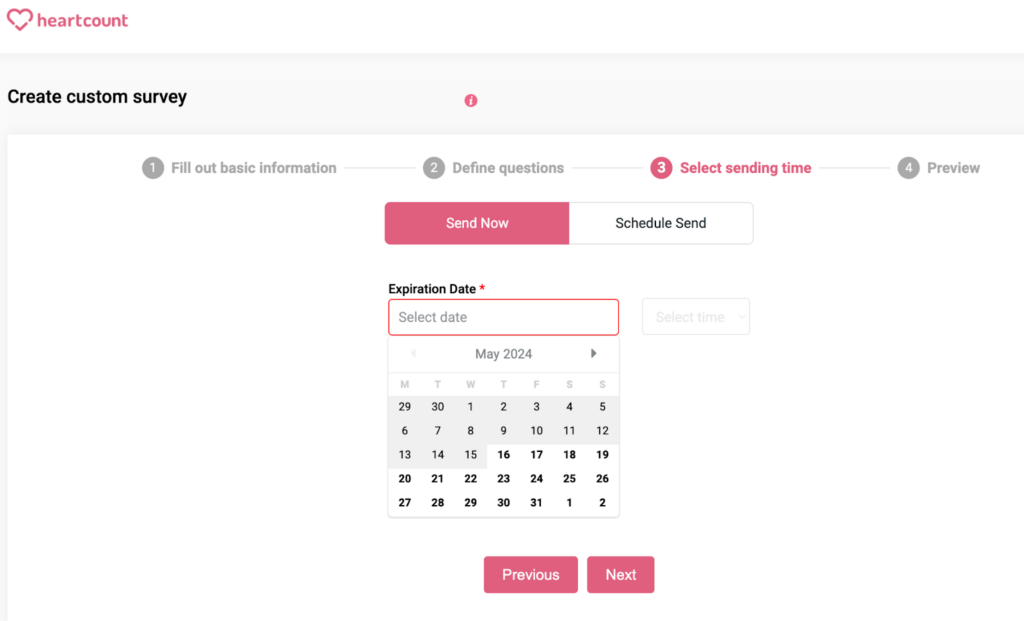
The gathered data is presented quantitatively and qualitatively for easy interpretation of results.
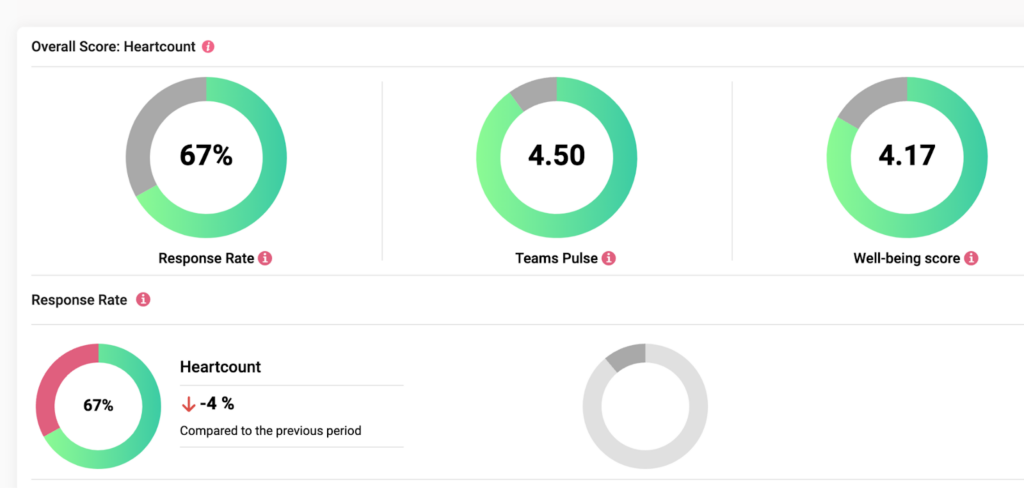
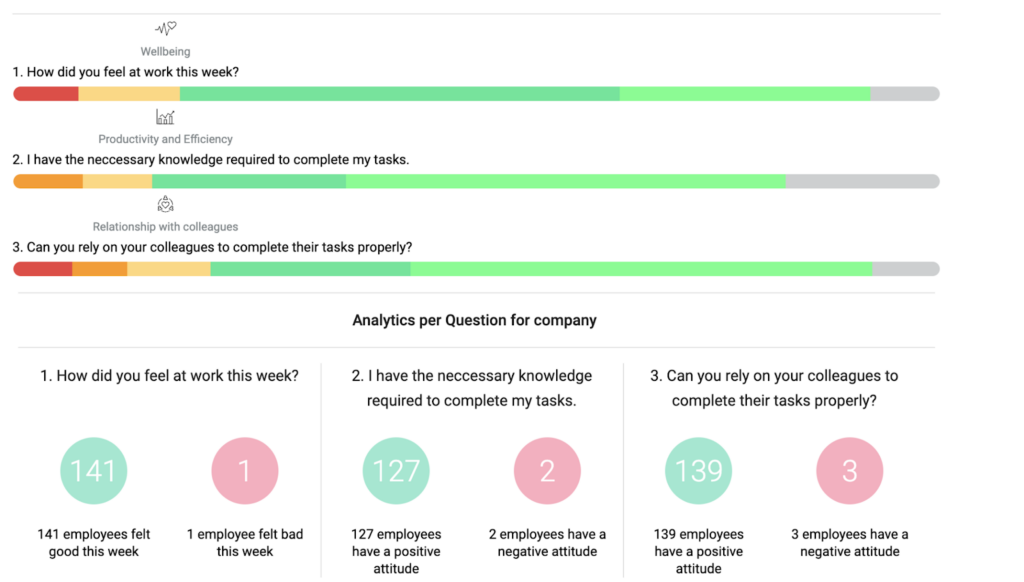
Using this data, you can identify and label critical employees and monitor their satisfaction levels over time.
If you want to improve your employee satisfaction survey and automate tedious tasks, HeartCount can help you.





